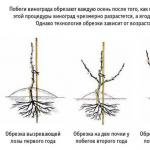incandescent lamp- This is an artificial light source in which light is emitted by a spiral of refractory metal heated by an electric current.
In 1874, Russian scientist Alexander Lodygin first introduced several light bulbs with a tungsten incandescent body. His samples became the prototype of all modern incandescent lamps.
All incandescent lamps, including halogen lamps, operate on the principle of heating the filament (body) to a temperature of 2700°K to 3000°K, as a result of the flow of electric current through them.
The design of incandescent lamps
The main element of any incandescent lamp is a filament, which is usually made of thin wire, less often ribbons, of tungsten. In order for the thread to be compact, it is twisted into a spiral, and the twisted thread is twisted into a spiral again, a double spiral is obtained. Thanks to this design, with a large length of the tungsten wire, the filament of the light bulb is compact.

For durability, the filament coil is placed in a flask from which air is pumped out. Otherwise, tungsten will quickly oxidize in the air and burn out. To increase the coefficient of performance (COP), the flasks of high-power lamps are filled with a mixture of nitrogen gases with inert argon. If high reliability is required, then the flask is filled with pure inert gas - argon, krypton or xenon under pressure, for example, halogen bulbs and for car headlights are filled with halogen vapors of bromine or iodine. But the cost of such bulbs is several times higher.
To supply electric current and fix the filament in the center of the bulb, current leads are used, in which the filament is crimped or spot-welded on one side, and their other ends are connected by soldering or spot welding to the base.
The threads of lamp bases are subject to GOST R IEC 60238-99, according to which sockets for 220 V are available in three types. E27 - the most common. E14 - in everyday life referred to as a minion (usually such bulbs are installed for illumination in refrigerators, microwave ovens). E40 - for lamps of street lamps. The number after the letter indicates the outside diameter of the base thread. Automotive bulbs for H4 headlights are produced mainly with a base according to the British standard (the base of the headlight bulb in the photo is in the center).

The base is not installed on capsular halogen incandescent lamps, the supply voltage is supplied directly to the current leads, made in the form of two pins. Sometimes the ends of the pins have a cylindrical thickening, which allows you to more securely fix the light bulb in the lamp and provide better contact with the contacts of the cartridge. To remove the light bulb from the cartridge of this design, you need to turn it a few degrees counterclockwise. The cylinders will disengage and the bulb will be released.
Incandescent lamp "Ilyich"
Incandescent lamps are quickly being replaced by energy-saving and LED light sources, as their cost has become comparable to the cost of Ilyich light bulbs.
The principle of operation of a light bulb is simple, an electric current passes through a tungsten filament. Since the specific resistance of the filament is hundreds of times greater than that of current-carrying conductors, it is heated to a temperature of more than 2000 ° and radiates thermal and light energy. Unfortunately, light radiation accounts for at best 4% of the power consumed. It would be more accurate to call a light bulb a heating element than a light source. Low efficiency is the main drawback of Ilyich light bulbs. The average bulb life is 1000 hours.
In Russia, according to the law of November 23, 2009 N261-FZ (as amended on April 23, 2018) “On energy saving and energy efficiency and on amendments to certain legislative acts of the Russian Federation”, from January 1, 2014, the use of incandescent lamps with a capacity of twenty-five watts or more for lighting in AC circuits.
Of course, the Ilyich light bulb, thanks to the advent of LED light sources, is living its life and will become history in the near future. The main disadvantages of incandescent lamps include low efficiency, significant heat generation, which imposes additional requirements on the thermal resistance of lamp fittings, a large dependence of the luminous flux and service life on the magnitude of the supply voltage (when the voltage is exceeded by 10%, the service life is reduced by 95%), fragility . Although the emission spectrum of incandescent lamps differs from that of the sun, the human eye has adapted to such light, since a candle has a yellow-red emission spectrum, the fire of a fire with which a person has lived for thousands of years.
A halogen lamp differs from an incandescent lamp in that it has smaller overall dimensions, higher efficiency and several times longer service life. In practice, this is the same light bulb "Ilyich", but improved with the latest achievements in science and technology. The flask of a halogen bulb is made of quartz glass and filled under pressure with bromine or iodine halogen vapors, due to which the service life of halogen bulbs is increased to 4000 hours, and the temperature of the coil reaches 3000°K.

In a halogen light bulb, the tungsten filament also evaporates when heated, but unlike a simple incandescent bulb, a cloud of tungsten, due to the chemical reaction with halogens at high temperature, returns back to the filament. Thanks to this process, it became possible to manufacture miniature high-power bulbs, increase efficiency up to 15% and increase the service life up to 4000 hours, and with the use of current limiters when the halogen bulb is turned on (the resistance of the filament in the cold state is ten times less than in the heated ) up to 12000 hours.
The emission spectrum of halogen bulbs is more natural than simple incandescent bulbs and they are an ideal artificial light source for color-related work such as artists. Since the light bulb bulb is made of quartz glass, it emits ultraviolet rays when it glows, which allows you to even sunbathe under it.
Halogen lamps in the car
Halogen bulbs for H4 car headlights currently have no alternative. High power, resistance to shaking and vibration, natural light, small dimensions, operation at any ambient temperature, long service life, low price - an almost ideal light bulb. There are, of course, more advanced bulbs for car headlights - xenon (they do not have a filament, the light emits a discharge between two electrodes in xenon gas), bi-xenon and LED, but their price is quite high.
Such bulbs cannot be installed instead of standard ones, but the entire headlight assembly needs to be replaced. In addition, the optics of headlights with xenon lamps must be kept in a perfectly clean condition; at the slightest pollution, the light begins to scatter and dazzle drivers of oncoming vehicles.

In one bulb of a halogen bulb for car headlights, two filaments are mounted at once. This solution made it possible to use one instead of two separate lamps.

The voltage on the filaments is applied in turn, depending on the need to turn on the dipped or main beam headlights. In such a light bulb, one output for two filaments is common and the bulb base has only three outputs.
Halogen bulbs, designed for a voltage of 220 V, are connected directly to the electrical network, and since power surges occur in the household network, the bulbs quickly burn out. Therefore, I advise you to use 12 V halogen bulbs with a step-down transformer or a ballast.
To avoid premature failure of a halogen bulb, contamination of the bulb is unacceptable, since it heats up to a temperature of 250 ° C, and dirt worsens heat removal and the bulb overheats. When installing a halogen bulb in a lamp, it is not allowed to touch the bulb with your hands, as sweat marks remain on it, which, when burned, violate the uniformity of heating of the bulb, as a result, the glass is stressed and the bulb may collapse. If accidentally touched, then the dirt from the flask must be removed with a solvent or detergent and must be dried before connecting the bulb to the mains.
Halogen lamps, depending on the level of mains voltage, are divided into two types: mains voltage 220-230 V and low-voltage - 12 V or 24 V.
The first group includes a large number of types that differ in power, size, base and purpose. Most often they are used in industry and outdoor lighting. But among them there are lamps for “home” use with a conventional E27 or E14 screw base with a power of up to 250 watts. They perfectly replace conventional incandescent lamps. They compare favorably with an almost twofold increase in service life and luminous flux. The main difference from conventional incandescent lamps is that halogen lamps have higher operating temperatures, so you should be guided by the rule: if the cartridge is rated for 150 W, then the power of the "halogen" should not exceed 100 watts.
There are also many types in the low-voltage group, but they have one thing in common - a step-down transformer, usually 12 V, is required to connect to the network. . If there is a space of 10 cm behind the false ceiling, this is quite enough to dissipate the generated heat. It is possible to mount lamps in bathrooms, only the degree of protection of lamps must be IP44.
In the spectrum of these light sources, there are indeed UV rays. They are even recommended to make up for the lack of natural light when growing crops. I know a case where a dress on a mannequin was lit with a halogen lamp in a boutique, and after two months a “burnt” spot formed.
Transformers (winding or electronic) lower the voltage from 220-230 V to 12 V. If it is designed for 150 W, then three 50 W lamps can be connected to it, but more than three are not recommended, even if their total power does not exceed this value .
Electronic transformers are somewhat more expensive than winding ones, but they are half the size and weight, they protect against overloads by turning off circuits in case of a short circuit, they do not create radio interference and provide a smooth start of lamps, extending their service life. Another important advantage is the slight heating of the case, which allows them to be used in furniture lighting and suspended ceilings.
It is not recommended to use dimmers (regulators) with halogen lamps, since low voltage increases the load on the transformer and reduces its service life.
The life of the lamp and fire safety depend on the correct choice of transformer. When buying it, pay attention to the country of origin, the presence of badges of certification bodies on the case and be sure to require the ROSTEST Certificate of Conformity.
Halogen lamps are similar in structure and principle of operation to incandescent lamps. However, they contain minor additives of halogens (bromine, chlorine, fluorine, iodine) or their compounds in the filling gas. With the help of these additives, it is possible in a certain temperature range to almost completely eliminate the darkening of the bulb (caused by the evaporation of tungsten atoms) and the resulting decrease in the luminous flux.
Halogen lamps, like incandescent lamps, emit heat. The spiral, made of heat-resistant tungsten, is in a flask filled with an inert gas. When an electric current passes through a spiral, it heats up, generating heat and light energy. Incandescence leads to the evaporation of tungsten particles, which settle as a black precipitate inside the flask. With increasing gas pressure, this process slows down. The size and low strength of the bulb of a traditional incandescent lamp do not allow increasing the pressure of the gas further. The higher the coil temperature, the more light is emitted. At the same time, the tungsten evaporation process is accelerated, which reduces the life of the incandescent lamp. In halogen lamps, most of these negative phenomena are eliminated.
In addition, the bulb of the halogen lamp is made of refractory quartz glass, which is more resistant to high temperature and chemical attack. Quartz glass is a heat-resistant material, and its small dimensions guarantee strength sufficient to create a higher gas pressure. Therefore, the size of the bulb in halogen incandescent lamps can be greatly reduced, as a result of which, on the one hand, it is possible to increase the pressure in the filler gas, and on the other hand, it becomes possible to use the expensive inert gases krypton and xenon as filler gases.
All this allows you to increase the temperature of the spiral, resulting in a 2-fold increase in light output (13-25 lm / W) and the service life of a halogen lamp (2-4 times higher than that of incandescent lamps).
Halogen lamps with an infrared reflective coating. Infrared radiation coated lamp bulbs are characterized by a significant increase in luminous efficiency.
This is due to the following physical process:
Part of the energy that is converted into invisible infrared radiation in conventional halogen incandescent lamps (more than 60% of the radiation output), is partly converted again into light in coated lamps. This is made possible by the structure of the coating, which transmits only visible light, and infrared radiation, if possible, returns completely to the helix, where it is partially absorbed. This causes an increase in the temperature of the coil, as a result of which the power supply can be reduced. Light output increases.
Advantages and disadvantages of halogen lamps
The advantage of halogen bulbs is increased light output at the same power consumption.
In the spectrum of these light sources, there are indeed UV rays. Halogen lamps are even recommended to make up for the lack of natural light when growing crops. There is a case when in a boutique a dress on a mannequin was illuminated with a halogen lamp, and after two months a “burned out” spot formed.
Halogen lamps emit a pleasant white light with a color temperature of up to 3200 K and excellent color rendering.
The light that they emit is closer than the light of all other lamps to the sun. Their small size, almost miniature, allows you to create completely new fixtures, such as the so-called accent lighting - a specially designed reflector system allows you to increase the flow of light so much that it gives designers additional options in decorating the room.
Compared to conventional incandescent lamps, halogen lamps have a luminous efficacy of 13-25 lm / W, a long service life and better luminous flux stability.
The miniature dimensions of halogen lamps are aesthetically more attractive (low-voltage halogen lamps (12 V, 100 W) have a bulb diameter 5 times smaller than incandescent lamps of the same power). It is no coincidence that today it is low-voltage halogen lamps that are used to illuminate racks, shelves, and various interior elements. All items look elegant, voluminous, and their colors become richer and brighter; the brilliance of glass and metal is emphasized. In addition, 12 V halogen lamps are completely electrically safe.
The range of halogen bulbs is much richer than conventional ones.
The halogen lamps produced today are very diverse and multifunctional (linear, capsule, reflector, etc.), which makes it possible to find such a lighting solution that the room requires in each case.
The main advantages of halogen lamps compared to incandescent lamps:
- 1. halogen lamps convert energy more efficiently,
- 2. have several times longer service life,
- 3. produce brighter white light,
- 4. more qualitatively convey the colors of the illuminated objects,
- 5. are produced in a richer assortment,
- 6. allow better control of the light beam and direct it with greater accuracy,
- 7. More compact, creating new design possibilities.
The main disadvantage is the blue shift of the spectrum. They have a “whiter” light than incandescent lamps, and with some ultraviolet light. If it falls on a thing painted with paint that is not resistant to light, then it will burn out much faster than from ordinary lamps - this must be taken into account.
Added: 04/28/2018 11:05:30 AM
More articles on this topic:
Halogen lamp
A halogen lamp (Fig. 167) consists of two main parts: a body (alcohol container) and a burner. The body / / is protected from the outside by a plastic case 2, which protects hands from burns.
The halogen lamp is very different from other light bulbs.
The spiral tungsten filament is located just along the axis of the tubular lamp of heat-resistant and durable quartz glass. In this position, the filament contains tungsten holders. The ends of the flask are hermetically sealed with gaskets. The flask is filled with an inert gas at a pressure of 106 Pa. Together with the gas, a small amount of pure iodine is introduced into the flask. The presence of iodine in the conical flask allows the tungsten tulle to be returned to the filament while the lamp is operating.
Halogen lamps can run on ethanol, gasoline or propane. For example, a propane lamp consists of a propane cylinder, a propane supply regulator, a burner, an ejector, a copper mesh, a rubber tube.
If you are holding the lamp in one hand, insert the other end of the hose into possible leaks and follow the color of the flame. When the lamp is lit, air is absorbed through the rubber tube into the burner. With small arrows of Freon, the flame turns green, generally purple.
The work of a halogen lamp is based on the properties of freon to change the color of the flame in the presence of hot copper from pure blue to green and blue.
Combine a halogen lamp with alcohol and prepare it for testing. The flame of the lamp should burn evenly, without noise, with a flame.
To detect a leak, a halogen lamp is lit and the color of its flame observed as the gases pour out into locations close to the surface of the test vessel.
In this case, the tip of the suction pipe moves along the surface of the vessel at a speed of approximately 25 cm/s. Since freon is 4 times heavier than air, it is recommended to look for freon at the lower edges of suspect leak areas. A small amount of freon flame in green, a large one in purple.
After checking the tightness with a halogen lamp, the block is painted (MS-17 enamel) and weighed. The weight of the charged unit is indicated in the repair certificate.
Check the sealed system with a halogen lamp. When a leak is confirmed, the system is considered ready to be charged with refrigerant.
Normal condenser cooling conditions are guaranteed before the system is filled with refrigerant.
These lamps, called metal halide lamps, are structurally identical to DRL lamps. Halogen additives are put into the discharge tube, which complements the palette of sodium sodium yellow line, melt green line and India blue lines, which not only increases the light output by 5-2 times, but also greatly improves color reproduction compared to XRD lamps.
Overview of characteristics of halogen lamps
The location of the freon ether is determined using a halogen lamp or an electronic leak detector, as well as the oil surface. Gas Freon-12 is 3-5 times heavier than air.
The liquid does not carry an electric current.
In recent years, there has been a growing prevalence of halogen lamps - iodine lamps. The emission spectrum of a halogen lamp is closer to natural.
After checking the tightness of the connections with a halogen lamp, the block is deposited with MS-17 enameled alkyl styrene base and dried for 30-40 minutes in an air atmosphere.
Compared with other light bulbs, the advantages of halogen bulbs are double the lifespan, 20% more light output, high strength and power, and smaller size.
Pages: 1 2 3 4
Quartz glass halogen lamp - a tungsten filament lamp filled with halogen gas. Used in headlights due to its high efficiency (lumens per watt), long life and no darkening of the glass.
A halogen lamp is an incandescent lamp in which a buffer gas is added: a pair of halogens (bromine or iodine).
All about halogen lamps
Buffer gas increases lamp life to 2000-4000 hours and allows higher filament temperature. At the same time, the operating temperature of the spiral is approximately 3000 K. The effective light output of most mass-produced halogen lamps for 2012 is from 15 to 22 lm / W.

Operating principle
In an incandescent lamp, an electric current, passing through a filament body (usually a tungsten filament), heats it to a high temperature.
When heated, the glow body begins to glow. Due to the high temperature, tungsten atoms evaporate from the surface of the filament (tungsten filament) and are deposited (condensed) on the less hot surfaces of the bulb, limiting the life of the lamp.
In a halogen lamp, the iodine or bromine surrounding the body of heat (together with residual oxygen) enters into a chemical combination with the evaporated tungsten atoms, preventing the latter from deposition on the flask.
This process is reversible - at high temperatures near the heating body, tungsten compounds decompose into constituent substances. The tungsten atoms are thus released either on the helix itself or near it. As a result, the tungsten atoms are returned to the filament, which makes it possible to increase the operating temperature of the coil (for brighter light), extend the lamp life, and also reduce the dimensions compared to conventional incandescent lamps of the same power.
Halogen lamps work equally well on AC and DC. When using soft start, the service life can be increased to 8000-12,000 hours.
Advantages and disadvantages
A significant disadvantage of halogen lamps is low-frequency noise when used in an alternating current network in conjunction with a dimmer.
The luminescence spectrum of a halogen lamp, like an incandescent lamp, is close to that of the sun.
compactness The addition of halogens prevents the deposition of tungsten on the glass, provided that the glass temperature is above 250 °C.
Due to the absence of blackening of the bulb, halogen lamps can be made very compact. The small volume of the flask makes it possible, on the one hand, to use a higher working pressure (which again leads to a decrease in the rate of evaporation of the filament) and, on the other hand, to fill the flask with heavy inert gases without a significant increase in cost, which leads to a decrease in energy losses due to heat conduction. All this increases the life of halogen lamps and increases their efficiency (COP).
Color rendering Halogen lamps have good color rendering (Ra 99-100), since their continuous spectrum is close to that of a black body with a temperature of 2800-3000 K.
Their light emphasizes warm tones, but to a lesser extent than the light of conventional incandescent lamps.
Application
Although halogen lamps do not reach the efficiency of fluorescent lamps, and even more so LED lamps, their advantage is that they can be used without any modifications to replace conventional incandescent lamps, for example, with dimmers and illuminated switches ("with a light") .
Halogen lamps are also actively used in car headlights due to their increased light output, durability, resistance to voltage fluctuations, and small bulb sizes.
Powerful halogen lamps are used in spotlights, ramps, as well as for lighting in photo, film and video shooting, in film projection equipment, in offset and flexographic printing and silkscreen printing, for exposing and drying materials sensitive to ultraviolet radiation.
Halogen lamps with a low body temperature are sources of infrared radiation and are used as heating elements, for example, in electric stoves, microwave ovens (grill), soldering irons (soldering thermoplastics with infrared radiation).
Execution
Halogen lamps can be manufactured both in compact sizes MR16, MR11 with a GU 5.3, G4, GY 6.35 (for 12 volts) or G9, GU10 (for 220 or 110 volts) base, and with an Edison E14 or E27 base (for 220 or 110 volts), linear with R7 base of various lengths (L=78 mm, L=118 mm, etc.). The flask of lamps can be transparent, frosted, and also have a reflector and / or a diffuser.
Lamps of standard sizes MR are intended for installation in vehicles (cars, motorcycles, bicycles), and when connected through a transformer to a household network, they can be used for stationary lighting (“spotlights”, compact lamps).
GU lamps are used for stationary lighting and, unlike MR lamps, are connected to the household network without a transformer. You can determine the type of lamp (MR or GU) installed in a luminaire or light “point” without removing the lamp by tracing the nature of the change in the brightness of the lamp when it is turned on and off.
The GU lamp lights up and goes out almost instantly, and the MR lamp is smoother, having a certain inertia (about 1/2 second).
Lamps with an E14 (minion) or E27 (standard) base are designed to replace conventional incandescent lamps.
They are equipped with an additional outer bulb (in shape and size resembling the bulb of conventional incandescent lamps), which protects the inner quartz bulb from contamination, accidental contact and contact with fusible materials.
Operation features
Halogen lamps are very sensitive to greasy contaminants, so their inner flasks should not be touched even with cleanly washed hands.
Due to the high temperature of the flask, any surface contaminants (such as fingerprints) quickly burn out during operation, leaving blackening. This leads to local increases in the temperature of the flask, which can cause its destruction (therefore, due to the high temperature, the flasks are made of quartz glass).
When installing lamps, hold the lamp bulb through a clean cloth (or clean gloves), and if accidentally touched, carefully wipe the bulb with a lint-free cloth (for example, microfiber) with alcohol.
Since the bulb of a halogen lamp is heated to fire hazardous temperatures, it should be mounted in such a way as to completely eliminate any possibility of its contact with any nearby objects and materials, and even more so with the human body.
When using a halogen lamp with a dimmer, it is necessary from time to time to turn on the lamp at full power for 10 minutes to evaporate the precipitate of tungsten iodide that has accumulated on the inside of the bulb
IRC halogen lamps
A new direction in the development of lamps is the so-called IRC-halogen lamps (the abbreviation "IRC" stands for "infrared coating"). A special coating is applied to the bulbs of such lamps, which transmits visible light, but delays infrared (thermal) radiation and reflects it back to the spiral.
Due to this, heat loss is reduced and, as a result, the efficiency (COP) of the lamp is increased. According to OSRAM, energy consumption is reduced by 45% and the service life is doubled (compared to a conventional halogen lamp).
Such a halogen lamp with a power of 65 W gives a luminous flux of 1700 lm, that is, it has a light output of 26 lm / W. This is about half the light output of a 30 W (1900 lm) compact fluorescent lamp required to produce the same light output, and twice that of a simple incandescent lamp.
To date, there are several alternatives to the familiar and familiar to all incandescent lamps - energy-saving, LED, halogen.

Each of them has its own principle of operation, energy consumption, light output, its own advantages and disadvantages. We offer you to compare LED and halogen lamps according to the main criteria - perhaps this will help you make a choice.

Will there be winners in this dispute?
COMPARISON OF LED AND HALOGEN LAMPS
|
Comparison criterion |
LED lamps (LED) |
Halogen lamps |
|
Operating principle |
The basis of LED lighting is the principle of operation of semiconductors, because. LED light diodes (Light emitting diode) inside the lamp are semiconductor and work on the principle of using a p-n junction. This means that energy is formed during the movement of positive and negative charges and the maximum part of it is released in the form of photons of visible light. |
The principle of operation is similar to the production of light in incandescent lamps, where the main role belongs to the tungsten wire, which is also the incandescent body in halogen lamps, and glows under the influence of an electric current. The main difference is that the lamp bulb is filled with halides, which return tungsten vapor to the incandescent body, significantly extending the lamp's life. |
|
Filling the lamp bulb |
Filling the flask does not matter, because. the light comes directly from the diodes and has no chemical component. Therefore, the flasks serve as a light diffuser and as protection for the diodes from dust and moisture, or they may be completely absent. |
Inside the flask is a vacuum or an inert gas (nitrogen, argon, krypton). Halogen lampThe tungsten filament is supplemented with active substances that are responsible for the chemical cycle. |
|
Heating during glow |
LED lamps have a minimum heating - up to 50 ° C |
Halogen lamps have a relatively high heat output -1 50 ° C |
|
Distribution and consumption of electricity |
All electricity is directed to the formation of photons of light. Low power consumption - 8-10 times lower than conventional incandescent lamps. |
Most of the energy is consumed in heating the filament, and a small part in the production of light. Energy consumption is 20-50% lower than conventional incandescent lamps. |
|
Life time |
From 30 to 100 thousand continuous burning. |
2000-2500 hours continuous burning |
|
Equivalent power (Watt) |
To replace a 100 watt incandescent bulb, you need a 10 watt LED bulb |
To replace a 100 watt incandescent bulb, you need a 60 watt halogen bulb |
|
Brightness (lm) |
||
|
Luminous shade options |
The light of the LED lamp can be warm, neutral or cool white, as well as colored, depending on the diodes. |
Warm, but close to white color tone. They have a very high color rendering. |
|
Time to reach maximum brightness |
2-3 seconds |
2-3 seconds |
|
Restrictions |
Do not use devices with LED lamps in conditions where a uniform distribution of light is necessary, because. LEDs give a strictly directed light flux, which can cause blinding and “spotting” of lighting. Also, you should not use such lamps if the power sources and cooling systems are in doubt, because the use of LED lighting also implies the use of step-down transformers, rectifiers, current stabilizers. |
The lamps get very hot, so they should not be used in fire-hazardous lamps and chandeliers, and you should not use such lamps in networks with strong power surges. |
|
Operating temperature range |
||
|
Environmental friendliness |
Eco-friendly |
Emits a small amount of ultraviolet light |
|
Average retail price |
So, in general, in terms of their properties and qualities, LED lamps deserve the palm, but halogen lamps have one, but very significant trump card - this is the price.
Although in the transposition of the cost to light hours, the positions of the opponents are approximately equal. So, the choice is yours.
Lamps used in the car - incandescent, halogen and gas discharge lamps for cars. Types, marking, characteristics, features of operation
At the moment, there are a lot of varieties of lamps, respectively, with different requirements for them and performance characteristics.
At the dawn of the automotive industry, even wax candles were used to indicate dimensions and illuminate the road, but everything changed with the advent of a current source (battery) and the invention of the first electric light bulb (Edison's invention)
Incandescent lamps
A classic incandescent light bulb looks like a spherical glass ball made of silicate glass (flask) (Figure 1), there is a tungsten filament inside the lamp, while there is a vacuum in the lamp cavity.
The principle of operation boils down to the fact that when an electric current passes, electrons heat up the tungsten spiral and electromagnetic thermal radiation occurs with a glow effect. The average efficiency of such lamps is about 6-8%, in particular, the efficiency depends on the wavelength of the emitted light, and it depends on the temperature of the filament, which is limited for conventional lamps. The average temperature of the filament of incandescent lamps is 2000 K, at a higher temperature of the filament, it simply burns out.
That is, the manufacturing technology and materials do not allow obtaining the desired high temperature, thereby providing a spectrum close to the spectrum of the sun. In addition, the disadvantage of these lamps is the fogging of the bulb as a result of the settling of tungsten that escaped from the surface of the lamp filament at high temperatures, thereby limiting the permeability of the glass. The considerable length of the lamp filament complicates the task of focusing the beam of light by the headlight reflector, which limits visibility on the road.
Some types of incandescent lamps were produced with a double helix.
These lamps are marked with the index R2.
Ordinary classic light bulbs, although they were quite popular, are unfortunately not at all practical. It seems that at the moment the place for car incandescent lamps is only in the museum. Now even in the auto shop you can’t find ordinary incandescent bulbs on sale, which were replaced by halogen lamps.
Halogen lamps

figure 2 (Car halogen lamp)
Halogen lamps (Figure 2) solved some of the problems associated with conventional light bulbs.
Starting even from the shape, due to which the length of the filament has become shorter, and the bulb of the lamp is cylindrical made of quartz glass. In addition, in halogen lamps, instead of a vacuum, it is filled with an inert gas with halogen vapor (iodine, bromine, and others). The use of such a filler in flasks made it possible to carry out the physicochemical reaction of returning tungsten molecules back to the filament of a halogen lamp.
Thus, the glass of halogen lamps is, as it were, self-cleaning, thereby constantly passing more photons of light through the surface of the bulb.
How are halogen lamps different from incandescent lamps?
Halogen lamps made it possible to maintain a higher temperature of the filament, which changed the wavelength of the emitted spectrum and increased the efficiency of the lamps. The temperature of the filament of halogen lamps is 2700-3000 K. So why can't you take a halogen bulb with your hands, all because of the same high operating temperatures of this lamp. When touching glass, we always leave prints, and with them grease, dirt, and so on, which in turn affects the uneven distribution of temperature over the quartz bulb of a halogen lamp.
If the temperature regime is violated, the bulb may crack, thereby the halogen bulb will naturally fail. This requirement for maintaining the cleanliness of the surface of the lamp bulb can also be attributed to gas-discharge lamps, but more on them later. Currently, halogen lamps are the most common for automotive applications.
Discharge lamps

figure 3 (Automotive discharge lamps, xenon)
Discharge lamps (Figure 3) were the latest in the mid-90s. They look like halogen bulbs, but the principle of their work is completely different. The flask is filled with gas (most often xenon as inexpensive and providing work). In xenon, an electric arc is created between the electrodes, thereby emitting light.
The temperature of gas-discharge (xenon) lamps is the highest, so much so that, as you noticed, if you have ever seen xenon glow, the emitted spectrum has a blue tint due to the high temperature and low wave frequency. As a result, the efficiency of gas-discharge lamps is several times higher than that of halogen and conventional ones.
Discharge (xenon) lamps also have advantages due to the fact that it is impossible to shake off the filament here, which provides xenon lamps with durability and reliability.
The disadvantages of gas-discharge xenon lamps are additional equipment, the increasing multiplier of which supplies the lamps with a voltage of up to 20,000 volts, which is necessary to create an electric arc. And how strange plus and minus - this is too high a level of emitted light, which adversely affects road safety.
If gas-discharge (xenon) lamps are installed on the car, then these works must be carried out in the factory. You can read more about xenon headlights in the section of our website (Xenon light, xenon lamps in a car)
Marking lamps used in the car.
Automobile headlight lamps (high, low)
— H1, H2, H3, H4, H7
H1 are used for cars with separate headlights for high and low beam.
BMW, VAZ2106
H2 are for additional optics
H3 with an additional output in the form of a wire are used for fog lights.
H4 head optics are used and have a double filament
H7 is the last type of lamp for cars manufactured after 1995, for free-form headlights.
Automobile lamps HB - 1, 2, 3, 4 testify to their certification to the American standards.
As a result, they are usually installed on American and Japanese cars.
Automotive lamps D1 and D2 - gas discharge lamps are marked with this index.
Most car component manufacturers are constantly improving their products and releasing their brands - all-weather (Philips - Allweather), all-weather (Osram - All Season), durable (Philips and Osram - Long Life), with 30% increased light output ( Philips - Premium, Osram - Super) and emitting light with a blue tint (Philips - Blue Vision, Osram - Cool Blue, Trifa - Xenon Blue).
For more information on the applicability and marking of lamps, see the section of our website (Lamps used in a VAZ 2110 2111 2112 car)
Choosing automotive lamps for use in the car
So that later there are no problems with the lamps and the car due to the lamps, the following requirements must be observed:
Polycarbonate headlamps must be fitted with UV filter lamps.
This spectrum excessively affects the aging of polycarbonate headlights, clouding their glass.
It is best to choose a lamp based on the marking on the old lamp, and sometimes this marking is applied to the glass of the headlight, such an example is shown in Figure 4 (the inscription halogen means that a halogen bulb is recommended for use in this headlight);

It is forbidden to touch the glass bulb of the lamp with your fingers - the remnants of fat and dirt on the bulb will provoke uneven heating, and its subsequent cracking;
Buying lamps in sets is usually cheaper than buying lamps individually.
it is impossible to install more powerful lamps than recommended because of the possible overheating of the headlight glass and the appearance of cracks, as well as overheating of the connecting blocks and wires;
The inscriptions on the original lamps are usually applied with special equipment, and on a fake with a stamp and paint, respectively, they can be erased with a fingernail;
Energy-efficient, bright and environmentally friendly halogen bulbs are gaining more and more popularity, replacing standard incandescent lamps from chandeliers and lamps. However, even having decided to get a “halogen”, you can easily get confused in the assortment offered by stores: the variety of types, shapes, sizes and colors greatly increases the field of choice.
Of course, you can always turn to consultants for advice, but it is better to go shopping, knowing exactly the ultimate goal. For those who have not yet figured out halogens, below are detailed instructions on how to choose a halogen lamp for any lamp.

What is the difference between halogen
The principle of operation of halogens is similar to an incandescent lamp: the inert and halogen gases filling the flask react with the evaporating tungsten filament, and the transmitted electric current causes heat and light energy.

Despite the identical structure of work, such a lamp heats up less at the same power, and shines many times brighter.
The quality of work can be seen from the technical characteristics of halogen lamps:
- Average service life - 6500 hours of continuous operation (1.5-2 times longer than incandescent bulbs);
- Power within 1 W - 20 kW;
- Rated voltage depending on the type from 6 to 240 W;
- The heating temperature of the coil is approximately 3000°C;
- Light output from 15 to 22 lm per 1 watt.

For greater safety, the lamp has a double bulb, and its outer body is coated with a special solution of molten quartz.















In general, these features of the device cannot but affect certain “pluses” and “minuses” of halogen lamps.
Advantages and disadvantages
Halogen-filled lamps have won their popularity with an extensive list of advantages:
- Long service life, especially with smooth start;
- Stability of functioning without flickering and drops;
- High shell strength;
- Extensive range from compact to standard models;
- Low level of ultraviolet radiation;
- The most useful for vision is “white” light;
- Double flask, preventing the spread of fragments during the explosion;
- Economical consumption of electricity.

However, it is worth considering the weaknesses of halogen lamps, including the following points:
- Replacing and screwing in the lamps is possible only with gloves, using napkins or polyethylene, otherwise the grease from the fingers will remain on the case and lead to the failure of the device.
- Strong heating of the bulb, which can cause melting of plastic and other fire hazardous elements in the lamp.
- The mixture of gases that fill the body is considered poisonous to humans.
- Light bulbs do not withstand power surges, which can adversely affect the service life.

Types, shapes, sizes
The advantage of this type also lies in the typical variety of shapes, types and sizes of halogen lamps, which allows them to be used in almost any lighting design: spot sconces, built-in lighting, multi-track chandelier, street spotlights and much more.

There are the following types of halogens:
Linear got its name due to the elongated cylindrical shape, which makes them somewhat difficult to use in everyday life. However, when illuminating large storage and utility rooms, street spaces, they are often used, due to their high strength and brightness. Another “minus” is the increased power consumption.









Housing with an external or double bulb is considered the best among halogen lamps for lighting apartments. Reinforced protection reduces the risk of mechanical damage, scattering of fragments during an explosion, and the process of replacing the product does not require putting on gloves. A wide range of modifications offering a variety of shapes, coatings, and colors also become an advantage of the type.

Separately, light bulbs with an aluminum or infrared reflector are distinguished, capable of directing the flow of light into a certain plane. This variety is used in built-in lighting, spot sconces, table lamps and is an indispensable element of space zoning.

Capsule models have compact models and relatively low rated voltage, which allows them to be installed in multi-track chandeliers or solid lighting compositions.

How to choose a lamp for the home
Photos of halogen lamps brightly illuminating beautiful interiors fascinate and encourage a purchase. However, first of all, it is necessary to decide which model is necessary for a particular case, in which some recommendations will help.












Among the varieties for the home, all types are suitable, except for linear ones, used to illuminate large spaces;
- The standard and universal view is considered to be with an external flask;
- Halogens look perfect next to mirror, matte and wooden surfaces;
- It is important to focus on the available voltage in the network and the number of lamps installed in the chandelier (the sum of the powers should not exceed the permissible load);
- It is better to choose models with a tempered glass bulb.

Which halogen lamps for the home will be the best solution? The answer lies in the place, degree and purpose of their use, so before going to the store, do not forget to consider all the requirements that the purchased light source must meet.


Photo of halogen lamps























For economic reasons, many owners of private properties increasingly prefer halogen lamps, and traditional lamps with incandescent bulbs remain unclaimed. Of course, they also have disadvantages.
The principle of operation of halogen lamps
Consider in detail the principle of operation of halogen lamps. They work in much the same way as ordinary incandescent lamps. The traditional version has a huge frosted glass bulb. It is filled with a mixture of various gases, mainly nitrogen, argon, or both of these elements at once. In the central part there is a tungsten filament through which the lamp heats up to 2500 °C. Such a high temperature contributes to the creation of a glow. All white areas, including tungsten, can glow white during incandescence, however, with the help of a bulb, the illumination is cold or warm.
What is the difference between halogens and incandescent bulbs?
An ordinary lighting device, with an energy consumption of about 6 hours per day, can work up to 500 electric hours. Naturally, the following question arises in the head: “As a result of which it consumes so much electricity?” This is due to the fact that energy consumption is due to heating, which consumes twice as much electricity as the emission of light. Over time, due to the generated heat and strong heating, the tungsten filaments can burn out, and there are times when the lamps explode. This cannot happen with a halogen lamp - this is precisely the difference between it and an incandescent lamp.
What else is different about them? In addition, they may differ in gas content. Halogens use gas that was produced with tungsten evaporation, thus forming halogen vapor in the form of a gas. In combination with tungsten vapors that do not settle on the surface and disappear without any traces, the service life of the filaments is greatly increased. In addition, such an unusual mixture of gases provides a decrease in the temperature of the filaments. When halogen is used, the filament also spreads heat in the room, but already 1.5 times less than when nitrogen or argon is used.

Advantages and disadvantages
With the device of halogen lamps, their pros and cons are associated. First, let's define their advantages:
- Allows you to save on electricity.
The increased body temperature of the glow determines the increased light output of the halogen. Such lamps have a light output in the range from 15 to 22 lm / W. For comparison, the highest quality classic types of incandescent lamps are unlikely to be able to provide such a value at the level of even 11 lm / W. With an equal amount of illumination, the use of halogens allows you to significantly win in terms of power.
- Long service life.
Due to the incomplete regeneration of lighting materials and the increased pressure of the buffer-type gas in the tank, the wear of the spiral during the operation of such incandescent lamps is significantly reduced. For new specimens, the service life reaches 2,000–5,000 hours, which is a couple of times longer than incandescent lamps.

- Color rendition.
A technology that uses the glow of a source heated to high temperatures causes increased light emission, which is not so far from natural in its characteristics. Due to the increased temperature of the filament, the spectrum of the lamp shifts to the blue color of the sphere. However, their color rendering is approximately Ra 99–100.
- Compact dimensions.
Today, manufacturers can afford to produce flasks of minimal size. The same advantage makes it possible to use them as light sources in cars.
In addition to the above, we note among their advantages the ease of changing the intensity of illumination of the room and the perfect safety of use in any conditions, even at high humidity. With constant inspections with a multimeter, you are guaranteed to provide your device with high-quality and efficient operation. Circuit breakers prevent overload in an electrical circuit.

Now let's look at their shortcomings. The flask can be heated to fairly high temperatures, as a result of which there is a high probability of ignition of surrounding objects. Because of this, you need to take the necessary security measures. The lamps get so hot, also due to the accumulation of dirt on their outer area, that can cause local overheating of the bulb and premature failure of the device. Therefore, such devices must be used with great care.
In addition, the halogen light bulb has a high price, this is due to the use of special materials in its production. But their price is much lower than demanded, for example, luminescent sources. Halogen lamps, if they deteriorate, must not be thrown into the trash. Damaged equipment is either sent to a special container for further disposal, if available, or transferred to a company that specializes in such services.
Varieties
Today, many domestic and foreign companies produce spot halogen lamps for use in various types of networks - both standard and low-voltage.
- Linear halogen lamp.
This variety is similar to a quartz tube that has two outlets from two areas. They are usually produced with a length of approximately 98 mm. They are highly resistant to any type of mechanical damage. In many cases, it is necessary to install the device in a horizontal state. Lamps are high power. They are indispensable for lighting the interior with a large area.

- Lamps with external bulb
Such precise halogen lamps have replaced traditional incandescent lamps. In appearance, the bulb of such a device is similar to the bulb of incandescent lamps. External flasks are designed to protect internal quartz parts from dirt. They have smaller dimensions when compared with incandescent lamps of identical power. This type of lamp has a base. They are produced in various decorative options - in the form of a candle, a hexagon, and so on.
This is a small bulb with reflectors, which are responsible for the angle of inclination and the properties of light scattering. Aluminum reflectors are mainly used, they create a luminous flux in a certain direction; and interference, which uniformly scatter light rays in a cone of a certain volume. You can also use protective glass - it can be frosted, transparent or colored. Directional light bulbs are produced for use both in a standard electrical network and in a low voltage network. They are mainly used as a ceiling lamp for lighting in some areas of the interior. The composition of such lighting devices includes a two-pin reflector. To work in a network with a voltage of 6, 12 or 24 V, variants with various types of socles are used. To work in a standard lighting network, variants with the same G9 and G10 bases are used.

- Capsule executions.
This is a miniature flask, which has two outputs designed to be connected to the mains. They are usually used in cabinet and frameless luminaires. The main purpose is point devices for creating decorative lighting. Basically, they are installed in the ceiling or in interior details. To connect to a low-voltage network, a base G4, G5.3, GY6.35 is used. For operation in a standard lighting network, a G9 base is included.
A wide selection of dimensions, capacities and designs of halogen lamps makes it possible to use them in a wide variety of areas, and their pronounced advantages allow them to be widely used in domestic and industrial applications. In addition, lighting fixtures based on halogen parts are highly economical, efficient and safe.
A halogen light bulb is a type of incandescent lamp, its distinctive feature is the addition of halogen vapors (bromine or iodine) to the balloon (flask). Thanks to the buffer gas, the temperature of the tungsten wire coil increases and the life of the bulb is extended. To understand the benefits of halogens, it is necessary to consider how a halogen lamp works and how it works.
In an ordinary incandescent light bulb, when the coil is heated, the tungsten atoms begin to evaporate and condense in areas of the bulb with a lower temperature. However, filling the flask with halogen vapor causes the iodine or bromine to react with the tungsten, preventing it from settling on the flask. The reverse process occurs near the filament, where the compounds decompose when heated, and the tungsten atoms return to the coil, increasing its operating temperature.
The service life of halogens (or as they are popularly called - halogen lamps) is 2000-4000 thousand hours, and can be increased to 8000-12000 hours, subject to smooth switching. All halogen bulbs are divided into two groups: mains voltage (220V) and low voltage (up to 24V).
Characteristics of halogen lamps
- Luminous efficiency: 15-22 lm/W.
- Power: 1W - 20kW.
- Thread temperature: about 3000 degrees.
- Service life: 2000-12000 hours
- Voltage: 6, 12, 24, 110 and 240 V.
- Types: linear, capsule, with a reflector, with an external flask.
- Features of operation: you can not take it with bare hands, you need to use gloves.
The main types of halogen lamps
Capsular. The main distinguishing feature of "finger" halogens is their small size. The heating body can be located transversely or longitudinally, a reflector is applied to the back wall, so additional external reflectors are not required, as well as a protective glass bulb. Due to their compactness, such bulbs can be used to illuminate furniture, ceilings, commercial facilities, as well as in decorative lamps.

The light bulb consists of a small bulb with a reflector that distributes the light flux in space. There are many types of reflectors, but aluminum remains the most popular. They also differ in standard sizes (MR8, MR11, MR16) and radiation angles. A subspecies of such lamps are IRC halogens - with a special coating that does not transmit infrared radiation, but reflects it back to the spiral. As a result, heat loss and energy consumption are reduced and service life is extended. Lamps with a reflector are produced without a protective glass, with a protective transparent or colored glass. They are used for directional lighting, as general and local light sources.

Linear. One of the oldest halogens, produced since the 60s. They are a quartz tube with a length of 78 or 118 mm (this is the standard, but there are models of other sizes), in which the filament body is held in position with the help of brackets. Most linear halogen lamps should be positioned horizontally, secured in the luminaire with two sockets placed at the edges of the lamp. Modern models are used for both outdoor and indoor lighting, they have increased impact resistance.

In appearance, they are very similar to ordinary pear-shaped incandescent lamps, they have a standard Edison base: E14 or E27. They belong to the mains voltage group, that is, they can be connected directly to a 220 V network. Inside a transparent, matte, milky or other bulb there is a small linear or miniature halogen light bulb. The flask protects it from dust, dirt, accidental touches.

Types of halogen lamp bases
The base depends on the type of light bulb:
- capsule can have sockets G4, G5.3, GY6.35 (for voltage 12-24V) and G9;
- with reflector: low-voltage ones have two-pin connectors - GY4, GZ4, GU4, GX5.3, GU5.3, GY6.35 (the numbers after the letter are the distance between the pins), mains voltage - G9 and G10;
- linear: modern ones are available with an R7s plinth located on both sides;
- with external flask: standard Edison sockets E14 and E27.
Advantages and disadvantages of halogen lamps
Advantages:
- Light output. Due to the design of the light bulb and the materials used, the light output reaches 15-22 lm/W.
- Color rendition. Ra of halogen lamps reaches 99-100, they emphasize warm colors well (however, slightly less than conventional incandescent lamps).
- Compact design (the size of halogen lamps, especially capsule ones, is much smaller than most other light sources).
- Longer life than conventional incandescent lamps.
- Stable light throughout the entire service life.
Flaws:
- The high temperature of the flask requires enhanced fire safety measures.
- Contamination on the flask leads to the failure of the lamp, so they should not be touched by hands. That is why gloves are usually sold along with light bulbs.
- Additional UV filters are required.
- Not suitable for networks with frequent voltage drops.
Where are halogen lamps used?
Today, halogens can hardly compete with LED or energy-saving light bulbs, but they are great for replacing incandescent bulbs.
Due to their good light output and small size, they are used in car, motorcycle and bicycle headlights.

Powerful lamps have found their application in spotlights, equipment for film, photo and video filming, in offset printing. In addition, light bulbs with low power can be used as infrared heating elements.
Halogen or LED lamp: which is better?
There is no definite answer to this question, since it depends on the application, as well as special requirements for lighting characteristics. Although LED is more economical, practical and durable, most LED light bulbs have poor color quality (which is why some light bulbs will appear unpleasant regardless of color temperature).

















